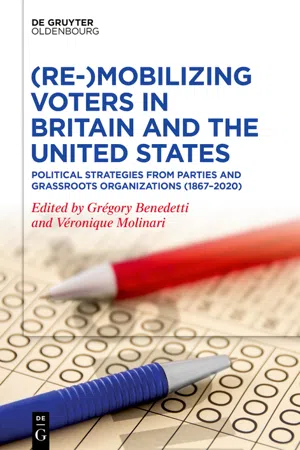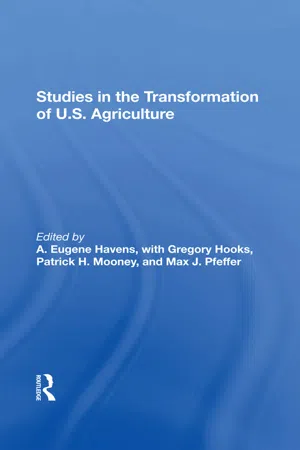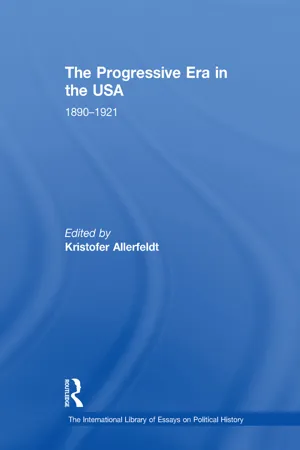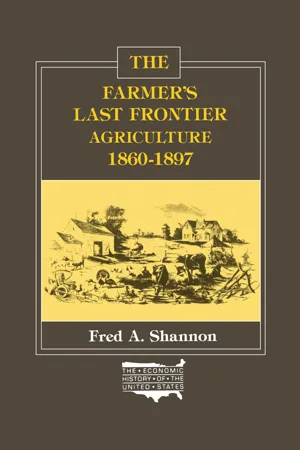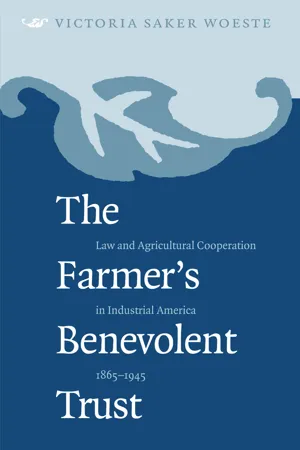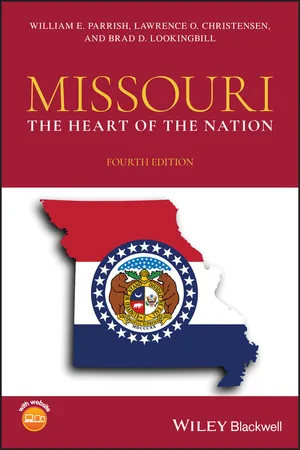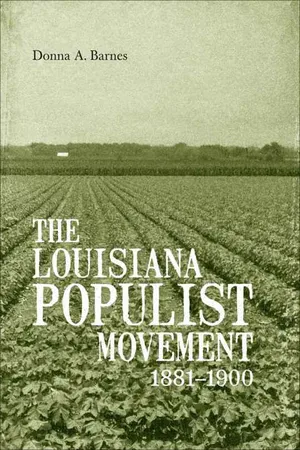History
Farmers Alliance
The Farmers Alliance was a movement in the late 19th century that sought to address the economic challenges faced by farmers in the United States. It aimed to provide a platform for farmers to advocate for their interests and to address issues such as high transportation costs and unfair lending practices. The movement eventually led to the formation of the Populist Party.
Written by Perlego with AI-assistance
Related key terms
10 Key excerpts on "Farmers Alliance"
- eBook - ePub
- Immanuel Ness(Author)
- 2015(Publication Date)
- Routledge(Publisher)
Although AAM continues to lobby for agriculture today, it has not survived intact. During the 1980s, several factions left AAM, Inc., to form Grassroots AAM, with original AAM founder Alvin Jenkins as chair. Little is known about this smaller group except that some members appeared to espouse more disruptive action, and that its strength emanated from eastern Colorado, western Kansas, and parts of Texas. AAM, Inc., developed a three point program to preserve independent farming based on minimum commodity prices, inventory control, and supply management, as well as a plan involving production quotas resembling one proposed in the 1930s by Milo Reno of the Farm Holiday Association. Currently, AAM, Inc., also lobbies for rural issues and is part of the National Family Farm Coalition, an organization committed to promoting a unified farm program.Ginette AleyBibliography
Browne, William P. "Mobilizing and Activating Group Demands: The American Agriculture Movement." Social Science Quarterly 64:1 (March 1983): 19-34.Browne, William P., and John Dinse. "The Emergence of the American Agriculture Movement, 1977-1979." Great Plains Quarterly 5 (Fall 1985): 221-235.Dyson, Lowell K. Farmers' Organizations . Westport, CT: Greenwood Press, 1986.Greene, Donald Miller. "The American Agriculture Movement: Its Cause, Spread, and Impact." Ph.D. diss., University of Oklahoma, 1979.Hurt, R. Douglas. American Agriculture: A Brief History . Ames: Iowa State University Press, 1994.McCathern, Gerald. Gentle Rebels: The Story of the Farm Protest of 1977 thru 1982 by Members of the American Agriculture Movement . Hereford, TX: Food for Thought Publications, 1982."Ploughing a Furrow to Washington." The Economist - eBook - ePub
(Re-)Mobilizing Voters in Britain and the United States
Political Strategies from Parties and Grassroots Organisations (1867–2020)
- Gregory Benedetti, Veronique Molinari, Grégory Benedetti, Véronique Molinari(Authors)
- 2021(Publication Date)
- De Gruyter Oldenbourg(Publisher)
Part 2: Mobilising Women: Grassroots Action and Political Discourse4 Mobilising Agrarian Men and Women in the Late Nineteenth Century
The Case of Farmers' Alliances and the Populist MovementJean-Louis Marin-LamelletIntroduction
In the 1880s and 1890s, Farmers’ Alliances in the American South and Midwest mobilised “periphery agrarians” – farmers, storekeepers, miners, railroad workers and nonconformist intellectuals – in a progressive farmer-labour movement advocating an antimonopoly and democratisation agenda. They were determined to give voice to all those economically and socially marginalised by Gilded Age finance capitalism: farmers at the mercy of monopolistic railroads in the Midwest, black and white sharecroppers ensnared by crop-lien system in the South but also workers exploited by corporate greed.1 The Farmers’ Alliances set up in rural Texas in the 1870s organised into a network of alliances. After Charles Macune became President of the Texas Alliance in 1886, it grew exponentially from 38,000 to 225,000 members in 1889. The Southern Alliance spread rapidly across the cotton South, merged with other organisations and then reached into the Wheat Belt, especially Kansas, and in California and the Rocky Mountain States. By 1890, the National Farmers' Alliance and Industrial Union (NFAIU) claimed 1.2 million members in 27 states, the “largest democratic mass movement in American history” according to historian Lawrence Goodwyn. Besides the NFAIU, several other organisations had similar objectives: the Chicago-based Northern Famers’ Alliance and in Illinois the Farmers’ Mutual Benefit Association. In the South, African Americans organised the Colored Farmers’ Alliance.2All these alliances mobilised agrarians who were left behind in the march of progress, overpowered by corporations and financial institutions and geographically and historically marginalised by prospering urban centres in the northeast. The different alliances pushed for radical reforms (progressive income tax and government ownership of transport and communications to name but a few) in an attempt to curb the threat wealth concentration posed for economic and political freedom. The movement also attracted all sorts of middle-class reformers and radicals. At the beginning of the 1890s, Farmers’ Alliances entered politics and created the People’s Party, also known as the Populist Party. This study focuses on Farmers’ Alliances. However, since there is no clear-cut separation between the two movements, it also deals with the beginning of Populism.3 As the movement was in full swing in the 1890s, the 14 founders of the original Texas Alliance posed in front of the cabin where their first formal meeting was held in 1877 in Pleasant Valley, Lampasas County, Texas.4 How did a movement that started with a dozen farmers eventually mobilise millions of Americans? The article will examine the strategies, tools and institutions Alliances used to mobilise their constituency and study one militant group that was particularly galvanised into action – women. The political and intellectual history questions raised by the “agrarian uprising” – discussed most notably in Charles Postel’s recent re-evaluation of Populism – will be considered from a double perspective: the sociology of social movements and book and periodical studies.5 - eBook - ePub
- James L. Hunt(Author)
- 2003(Publication Date)
- The University of North Carolina Press(Publisher)
2 AN ALLIANCE EDUCATION
WHILE MARION BUTLER established himself as a popular educator, some southern farmers began a political revolt. Declining crop prices, scarce money, high interest rates, lack of affordable credit, high transportation costs, and expensive manufactured goods protected by tariffs appeared as tangible symptoms of an unjust economy. More broadly, these farmers feared that the rural way of life, so revered in Jeffersonian rhetoric, was no longer preeminent. Yet neither economic depression nor a perceived decline in rural importance produced the agrarian movement of the 1880s. More important was a political confidence that something could be done to make things better. For southerners, the primary vehicle of hope was the National Farmers’ Alliance and Industrial Union. Under the leadership of Charles W. Macune of Texas, it promoted cooperative marketing of agricultural products, encouraged scientific farming, and demanded legislation reducing the power of corporations, especially railroads and national banks. The Texas Alliance was an all-white secret union that restricted membership to farmers, workers, country doctors, and teachers. Lawyers and merchants, representatives of urban and corporate greed, could not join. The order arranged itself in a hierarchical manner, with a local “sub-Alliance” composed of ten to fifty members as the basic unit. Above the sub-Alliances were county Alliances, state Alliances, and national Alliance organizations.1By the mid-1880s many North Carolina farmers, especially small and middling landowners, were complaining about declining prices for land, cotton, and tobacco, expensive credit, and high transportation and marketing costs. They feared losing their land for taxes or debts, growing increasingly resentful of the booming prosperity of North Carolina manufacturers, especially in the tobacco industry. They felt threatened by urbanization, as the promise of excitement and economic opportunities lured youth from the countryside. From the outset, some of their anger was directed at the state legislature, which appeared wholly unsympathetic to their problems.2 - A. Eugene Havens, Gregory Hooks, Patrick H Mooney, Max Pfeffer(Authors)
- 2019(Publication Date)
- Routledge(Publisher)
Throughout the summer of 1880 charters for local Farmers’ Alliances were granted to farmers’ groups across the Midwest. On October 14 a “Farmers’ Transportation Convention” was called and about 500 farmers—many of them representing local alliances, farmers’ groups, or Granges—attended the meeting in Farwell Hall in Chicago (Taylor, 1951:215). A national organization was formed, composed of local, state, and the national alliance, with the national body having little more than a coordination function. A constitution was passed which stated the following objectives:To unite the farmers of the United States for their protection against class legislation, the encroachments of concentrated capital, and the tyranny of monopoly; to provide against being imposed upon by swindlers, and swindling advertisements in the public prints; to oppose, in our respective political parties, the election of any candidate to office, state or national, who is not thoroughly in sympathy with the farmers’ interests; to demand that the existing political parties shall nominate farmers, or those who are in sympathy with them, for all offices within the gift of the people; and to do anything, in a legitimate manner, that may serve to benefit the producer (Taylor, 1953:215).The railroads were singled out as the chief enemy of both producers and consumers, and resolutions were passed calling them oppressive, defiant of the law, corrupting to politics, “a hindrance to free and impartial legislation, and a menace to the safety of our republican institutions” (Hicks, 1961:99).Within a year of its founding, the National Farmers’ Alliance claimed to have 1,000 locals. By its second convention it claimed a total membership of 24,500. At the third convention, in October 1882, the organization claimed 2,000 locals and a membership of 100,000. By 1887, the membership was four times as large (Taylor, 1953:216). Between 1883 and early 1885, however, the Alliance went into a period of decline, due in part to improved economic conditions resulting from good crops and a rise in prices. By the winter of 1884–1885, wheat prices dropped and hard times set in for farmers. By 1887 a new constitution was passed, dues were collected for the first time, state leaders became more active in the national affairs, and new demands were made including government ownership of the railroads and the unlimited and free coinage of silver. The growth of the Alliance following the 1887 convention has been attributed to the “complete and thoroughgoing awakening of class consciousness among the farmers …” (Hicks, 1961:104). The Southern Alliance was at the same time making more political demands, including higher taxation on lands held for speculation, prohibition of alien landownership, more taxation of railways, and new issues of paper money (Goodwyn, 1978; Hicks, 1961:106). Both Northern and Southern Alliances made conscious statements proclaiming their alliance with working people, and both Alliances had friendly exchanges with the Knights of Labor. Throughout the 1880s, the Knights of Labor expressed their solidarity with the demands of farmers for regulation and government ownership of the railroads and for new monetary policies; farmers, in turn, gave food to striking workers. The Knights of Labor reached its membership peak in 1886, following a successful strike against railroad baron Jay Gould. Farmers’ Alliance locals and members contributed money and food to the strikers, insisting that labor’s fight against Gould was their own fight (Foner, 1975:301).- eBook - ePub
- Kristofer Allerfeldt(Author)
- 2017(Publication Date)
- Routledge(Publisher)
By 1900, 36% of white and 75% of blacks were tenants or sharecroppers; most of the remaining “yeomen” were heavily and hopelessly in debt to bankers, landlords, and merchants. The average per capita income among the bottom three-quarters of the southern population ranged from $55 to $64 a year in 1880–1900 (Kousser, 1974, pp. 64–65; Saloutos, 1960, p. 237; Woodward, 1971, pp. 318–319). These were the conditions that gave rise to the Farmers’ Alliance, the largest and most radical mass movement for economic and political change in American history until the civil rights movement of the 1960s. Like the latter, the Farmers’ Alliance originated in the rural periphery and, while it spread into the plains states, had its most radical core in the South. At its peak it enrolled about three million members, including the allied Colored Farmers’ Alliance. After solid class opposition from bankers, merchants, manufacturers, and large landlords strangled its attempt to construct a counter-economy based on cooperative buying and selling, Alliance leaders turned to politics (Goodwyn, 1978; Schwartz, 1976). The derivative Populist Party advocated government ownership of railroads, an expanded currency not tied to gold or bonds, an income tax, a “subtreasury” plan for public warehousing and credit, labor organizational rights, and the eight-hour day (Tindall, 1966, pp. 93–96). Like the Alliance, it also endorsed the central demands of industrial and railroad workers, although the populist vote among urban workers in the 1890 and 1984 elections was miniscule. Meanwhile, populists swept Kansas, Nebraska, and the Dakotas, and Alliancemen, populists, and fusionists routed regular Democrats in the South. In 1896, William Jennings Bryan was the presidential nominee of both a “populized” Democratic Party (which had repudiated its northern conservative wing) and the Populist Party - eBook - ePub
The Farmer's Last Frontier
Agriculture, 1860-97
- Fred A. Shannon(Author)
- 2017(Publication Date)
- Routledge(Publisher)
Though the Grange dropped out of sight as a political force after the late 1870’s, farmers’ clubs continued their activities and tended to coalesce into alliances. In 1874 or 1875, Lampasas, Texas, had an alliance for catching horse thieves, recovering estrays, and buying supplies. It was a secret society which also fought land monopolists and the big cattlemen who were inclined to ignore the rights of small competitors. This idea soon spread to other counties and, in 1878, a Grand State Alliance was organized, only to be all but killed by dissensions over greenbackism. Revival was rapid, and in 1880 a new Grand State Alliance was incorporated by the state, as a benevolent society of a secret nature. By 1885, it claimed 1,200 lodges and 50,000 members. It fought against low prices, crop liens, and the oppression of the country merchants. By 1886, it was beginning to demand higher taxes on speculative landholdings, a ban on alien landowning, laws against dealing in futures, higher taxes on railroads, more paper money, and other issues later absorbed by the Populist party. These demands caused threats of further schism; whereupon C. W. Macune stepped forward, saved the Alliance, and started a movement for combination with other groups throughout the South.The largest of all these rivals started in Arkansas, in 1882, as a debating society, and in 1883 took the name of the Agricultural Wheel. By the processes of absorption and expansion, the Wheel extended into eight states by 1887, and claimed half a million members. The merger of the Alliance and the Wheel was effected in 1889, under the temporary compromise name of the Farmers’ and Laborers’ Union. Lawyers, merchants and their clerks, and stockholders in banks or stores of other than the cooperative variety were denied membership. By 1890, the enlarged society had a membership of over a million.38 Working in close sympathy with this alliance were the Fanners’ Clubs fostered by Benjamin R. Tillman in South Carolina.39During these same years, the farmers of the Northwest were also active in organization. The National Farmers’ Alliance, commonly called the Northwestern Alliance, may have had some generic connection with an alliance of Grangers in New York, uniting for political purposes, in 1877. The latter may have got the idea from a Settlers’ Protective Association started in Kansas in 1874, to help squatters in their fight against the railroad land monopolies. Such are the claims, though slightly overwrought. But it was Milton George of Chicago, editor of the Western Rural, who in 1880 established the alliance that, within two years, was to claim 2,000 local groups with 100,000 members. This organization followed on the heels of two or three years of hard times in the Prairie states. As conditions improved, in 1883 and 1884, interest lagged. Then, following low wheat prices in 1884-1885, membership picked up in all the wheat states of the Northwest, and by 1887 the Northwestern Alliance was beginning to demand such things as federal competition with railroads and the revival of free coinage of silver. In the Minneapolis convention of that year, there was some tendency to cooperate with the Knights of Labor. By 1890, the Midwest farmers were thoroughly class conscious. Kansas claimed 130,000 alliance members, while Nebraska, the Dakotas, and Minnesota were close rivals. The organization had already spread through fifteen states, and was reaching out for more.40 - eBook - ePub
Studies in Legal History
Law and Agricultural Cooperation in Industrial America, 1865-1945
- Victoria Saker Woeste(Author)
- 2000(Publication Date)
- The University of North Carolina Press(Publisher)
16Although leaders such as Macune spoke in Rochdalian terms, and notwithstanding the Alliance’s political kinship with “labor radicalism and Green-backer ideology,” the Populists did little more than use cooperation as a rallying cry. Like the Grange before it, the Farmers’ Alliance was unable to produce cooperatives that were commercially viable for more than a few years. They failed in part because they lacked sufficient capital and credit and in part because of the political emphases of the protest movements. Instead of focusing on exclusive service to members and devising organizations to address specific marketing problems, which varied among crops and regions, Granger and Alliance cooperatives aimed high, attempting to replace manufacturers in the 1870s and bankers in the 1880s.17Moreover, rank-and-file farmers learned through the failure of these organizations the difference between cooperative ideology and economic function. While both Granger and Populist leaders relied heavily on cooperative ideology, they assumed that the Rochdale model, which had been devised for collective purchasing, could be used for marketing without much modification. That was a critical misjudgment. Designed for collective purchasing, Rochdale cooperatives restricted their clientele and their business to a volume that members’ pooled capital could support. The restriction on capital stock was the very feature that supposedly distinguished it from profit-making corporations. Collective marketing, in contrast, required large outlays of capital well in advance of actual returns. This need grew in proportion to the scale of marketing operations. Regional or national operations required larger investments of capital, skill, management, communications, and other inputs. If farmers decided to begin or continue their collective action at the processing stage, they needed money to buy or build these facilities. Limited by statute to nominal amounts of capital stock, Rochdale cooperatives did not possess the resources necessary to undertake these activities. The Granger and Alliance organizations testified to this limitation even as they expanded Rochdale’s political and ideological appeal.18 - eBook - ePub
The Selected Works of Eugene V. Debs, Vol. I
Building Solidarity on the Tracks, 1877–1892
- Tim Davenport, David Walters(Authors)
- 2019(Publication Date)
- Haymarket Books(Publisher)
Purposes are more sharply defined; methods are characterized by more wisdom and tact. There is a more acute discernment of the end in view. There is larger intellectual grasp, and the promise of ultimately securing redress for wrongs could scarcely be more flattering. In this work of organization for bettering conditions, the farmers of the United States have become conspicuously prominent. They have felt the oppression of trusts, syndicates, combinations, and monopolies, which acting under the sanction of law and a corrupt judiciary, promise at no distant day to wreck them and reduce them to the condition of serfs. In the first place the farmers organized what was called the “National Grange.” 1 Then came the “Farmers’ Alliance.” 2 Following this was the “Farmers’ Union,” 3 and then came the “Agricultural Wheel.” 4 At one time the “National Grange” had 32 states in line, with 20,000 subordinate granges and a membership of 800,000. It now has a membership of about 200,000. There is another farmers’ organization known as the “Farmers’ Mutual Benefit Association.” 5 These various organizations having a membership of above 1 million federated in the city of St. Louis in December last [1889]. That they should have done this was logical. Acting separately they could accomplish little; together they are strong. Federation means harmonious action. If there are bad laws, it means their repeal. If there are vicious, corrupt lawmakers it means their retiracy to private life. If there are corrupt judges, it means that in due time they shall be stripped of their ermined robes and be removed to obscurity. This farmers’ movement means that a large majority of the “4.5 million farmers” of the country will become members of the “Farmers’ Alliance” for the purpose of bettering their condition - eBook - ePub
Missouri
The Heart of the Nation
- William E. Parrish, Lawrence O. Christensen, Brad D. Lookingbill(Authors)
- 2019(Publication Date)
- Wiley-Blackwell(Publisher)
In 1880 Thomas T. Crittenden of Warrensburg and his Democratic colleagues easily defeated their Greenback and Republican opponents. Governor Crittenden made no obvious overtures to agricultural demands, except for breaking up the James gang. Crittenden's Democratic successor, John Sappington Marmaduke of St. Louis, however, called a special session of the legislature to urge increased state supervision of railroads. Marmaduke had defeated Nicholas Ford of Andrew County, a Greenback–Republican fusion candidate, by about 10,000 votes and believed that legislative action was necessary. The General Assembly responded with a law that forbade unjust discrimination of freight charges, empowered the railroad commission to set maximum rates, and established substantial penalties for offenses. This reflected the general mood of the times, for five months earlier Congress had approved the Interstate Commerce Act in a federal effort to regulate railroads. Marmaduke died on December 28, 1887, and Lieutenant Governor Albert P. Morehouse of Maryville served out the remainder of his term in office.The Alliance Movement
Farmers in Missouri turned to the National Farmers' Alliance and Cooperative Union of America and the National Agricultural Wheel in their efforts to improve their conditions. Formed in Texas during 1884 and later combined with a Louisiana organization, the Farmers' Alliance entered Missouri in 1887. By August 1888 it had organized 615 local or sub‐alliances in 38 southern counties. The Agricultural Wheel began in Arkansas in 1882 and entered Missouri in 1886, the same year that eight state groups formed the national organization. In 1889 the Alliance and Wheel united, forming the Farmers' and Laborers' Union of America.Still called the Farmers' Alliance, the new organization insisted that farmers form cooperatives, educate themselves about the issues of the day, and learn scientific farming techniques. Through the lecturer system whereby paid and unpaid individuals discussed farm problems and literature that advocated reform, farmers learned new approaches to agriculture and broadened their knowledge of society. Uriel S. Hall of Moberly served as state lecturer in Missouri during 1889. One contemporary Missourian called the alliance movement a national university that inspired and stimulated farmers to think critically. By 1889 Norman Colman, editor of Colman's Rural World, estimated membership of the movement at 200,000.Democratic Response
Although Populism surfaced in many forms, Democratic candidates retained all of the statewide offices in 1888. Democrat David R. Francis, a grain dealer, the former president of the St. Louis Merchants' Exchange, and the former mayor of St. Louis, captured the governorship over Republican E. E. Kimball of Nevada by 13,233 votes. Democrats also won 10 of 14 congressional races and continued their control of both houses of the General Assembly. While losing nationally in his bid for reelection, Democratic President Grover Cleveland surpassed Republican Benjamin Harrison in Missouri by 25,691 votes. - eBook - ePub
- Donna A. Barnes(Author)
- 2011(Publication Date)
- LSU Press(Publisher)
Table 3 indicates, in most southern states the majority of sharecroppers were white. Given the predominance of black sharecroppers in Louisiana, any attempt to develop strategies to more effectively mobilize that aspect of the farming community entailed reaching out to blacks. This would have required a transformative shift in identity framing, wherein the importance of race differences was minimized and the importance of shared economic grievances heavily emphasized. Given the white supremacy culture of the times, any major effort to broaden the race and class appeal of the movement in Louisiana may well have faced insurmountable challenges.In sum, the strategy choices of the early Alliance movement were inextricably linked to its status as a class-based organization of primarily small farm owners. The strategies were not well suited to the needs of tenant farmers, and consequently recruitment success among tenant farmers was modest. The fact that most tenant farmers in Louisiana were black played a significant role in the failure to mobilize a broad-based agrarian movement. The limited mobilization compromised the Alliance, eventually undermining the effectiveness of its early strategies. Contrary to Schwartz’s claim, the Alliance was not in a good position to mold and reshape the system of cotton supply and sales. Its attempt to bolster the price of cotton through cotton-bulking and cotton-withholding schemes was about as effective as holding back flood waters with a bucket. While the strategies represented a sincere effort to abate the economic crisis, they were simply not up to the challenge of remedying the monumental problems facing the cash-starved, lien-dependent farmers.POLITICAL REACTION TO THE SMALL-FARMER MOVEMENT
As noted previously, initial efforts by Tetts and Skinner to mobilize Louisiana’s small farmers met with minimal success. The lack of success, however, was not due to a hostile or unfavorable political climate. Mobilization efforts had met with such little success that they did not even register on the state’s political barometer. An extensive search of the newspapers from 1881 through 1886 demonstrated that the nascent LFU was given almost no attention by the media and political establishment. Not a single negative statement about the LFU could be found.The growth of the LFU following its merger with the Alliance was dramatic. As it grew, newspapers started to pay attention to it and were generally accepting of its ideology and strategies. Even the conservative editor of the Shreveport Daily Times stated that from what he knew of the Alliance and LFU “great good should result to the farming class from their establishment.” The editor then added that the general public should benefit as well since “a depressed agricultural interest means depressed business everywhere.”90 The president of the planter-dominated Louisiana State Agricultural Society also declared the LFU to be a “beneficent organization.”91
Index pages curate the most relevant extracts from our library of academic textbooks. They’ve been created using an in-house natural language model (NLM), each adding context and meaning to key research topics.

